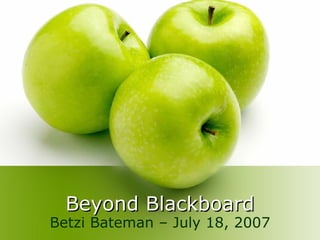Beyond Blackboard
- 1. Beyond Blackboard Betzi Bateman ĻC July 18, 2007
- 2. Blogs Definition: posts made by an author(s) in reverse chronological order Purpose: reflection or sharing of information with comment from others
- 3. Blog Examples CSU Organizational Leadership Cohort Blog MasterĄŊs program for future educational administrators Instructional problem: How do we promote communication and community among a cohort of students that extends beyond the classroom? How do we do this with students who are busy adults and geographically dispersed? http://csuorgleadership.wordpress.com
- 4. Blog Examples Photocritic ĻC BGSU blog for student photo critiques Instructional problem: students do not seem comfortable critiquing other studentsĄŊ photographs; students do not know HOW to critique other studentsĄŊ photographs. Can a blog help? http://www.pseudobook.com/photocritic
- 5. Wikis Definition: an easy-to-update collaborative website (Ą°wikiĄą is quick in Hawaiian) Purpose: collaborative product/authoring Ą° Wikis in plain EnglishĄą http://www.youtube.com/watch?v=-dnL00TdmLY
- 6. Wiki Examples Ą° The Romantic AudienceĄą project Bowdoin College Romantic poetry course Instructional problem/goal: how do I get students to dig deep into the meaning of a poem? http://ssad.bowdoin.edu:9780/snipsnap/eng242-s05/space/
- 7. Wiki Examples WSU ĻC Student Created Study Guide CE211 ĻC tips posted by students for students Instructional goal/problem: student created? http://wiki.wsu.edu/wsuwiki/CE211_Study_Skills
- 8. Social Networks Definition: a place where people connect online through sharing a personal profile and through various communication tools Purpose: Community
- 9. Social Networking Example College 2.0 A social network created using the Ą°NingĄą application Goal: bring together folks interested in elearning and the future of education http://college2.ning.com
- 10. Why does this matter? Ą° Education often preaches instead of teaches. Instead of learning solutions to yesterdayĄŊs problems, people need to learn how to deal with the unknown. In the real world, the issues we face are ones that no one knows the answers to. Can we afford not to learn how to learn and find more and better ways to learn everything we will need to do in the days and years to come?Ąą - Marcia Conner, former education director at Microsoft and PeopleSoft, quoted in the book Informal Learning by Jay Cross
- 11. Thank You! Betzi Bateman [email_address] RT 944 ext. 9207 http://academic.csuohio.edu/bateman_b










![Thank You! Betzi Bateman [email_address] RT 944 ext. 9207 http://academic.csuohio.edu/bateman_b](https://image.slidesharecdn.com/beyond-blackboard1703/85/Beyond-Blackboard-11-320.jpg)